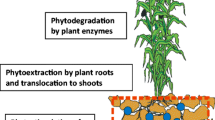Abstract
Phytoremediation of pollutants in soils is an emerging technology, using different soil-plant interaction properties. For organic pollutants, such as polycyclic aromatic hydrocarbons (PAHs), phytodegradation seems to be the most promising approach. It occurs mostly through an increase of the microbial activity in the plant rhizosphere, allowing the degradation of organic substances, a source of carbon for soil microbes. Despite a large amount of available data in the literature concerning laboratory and short term PAH phytodegradation experiments, no actual field application of such technique was previously carried out.
In the present study, a soil from a former coking plant was used to evaluate the feasibility and the efficiency of PAH phytodegradation in the field during a three years trial and following a bioremediation treatment. Before the phytoremediation treatment, the soil was homogenized and split into six independent plots with no hydrological connections. On four of these plots, different types of common plant species were sowed: mixture of herbaceous species, short cut (P1), long cut (P2), ornamental plants (P3) and trees (P4). Natural vegetation was allowed to grow on the fifth plot (P5), and the last plot was weeded (P6). Each year, representative sampling of two soil horizons (0–50 and 50–100 cm) was carried out in each plot to characterize the evolution of PAHs concentration in soils and in soils solution obtained by lixiviation. Possible impact of the phytoremediation technique on ecosystems was evaluated using different eco- and genotoxicity tests both on the soil solid matrix and on the soil solution.
For each soil horizon, comparable decrease of soil total PAHs concentrations were obtained for three plots, reaching a maximum value of 26% of the initial PAHs concentration. The decrease mostly concerned the 3 rings PAHs. The overall low decrease in PAHs content was linked to a drastic decrease in PAHs availability likely due to the bioremediation treatment. However, soil solutions concentration showed low values and no signficant toxicity was characterized. The mixture of the herbaceous species seemed to be the most promising plants to be used in such procedure.
Similar content being viewed by others
References
AFNOR: 1994, ‘Qualité du sol — Effets des polluants vis–à—vis des vers de terre (Eisenia fetida)—Partie 1: détermination de la toxicité aigüe en utilisant des substrats de sol artificiel’, Norme X 31–251.
AFNOR: 1998a, ‘Qualité du sol: Essai de lixiviation’, Norme XP X 31–210.
AFNOR: 1998b, ‘Détermination de la toxicité chronique des eaux par inhibition de la croissance de l'algue d'eau douce Pseudokirchneriella subcapitata (Selenastrum Capricornutum)’, Norme NF T 90-375.
AFNOR: 2000, ‘Détermination de la toxicité chronique vis‘à—vis de Ceriodaphnia dubia en 7 jours’, Norme NF T 90-376.
Alkorta, I. and Garbisu, C.: 2001, ‘Phytoremediation of organic contaminants in soils’, Bioresource Technology 79, 273–276.
Anderson, T. A., Guthrie, E. A. and Walton, B. T.: 1993, ‘Bioremediation’, Environmental Science and Technology 27, 2630–2636.
Aprill, W. and Sims, R. C.: 1990, ‘Evaluation of the use of prairie grasses for stimulating polycyclic aromatic hydrocarbon treatment in soil’, Chemosphere 20, 253–265.
ATSDR: 1995, Polycyclic Aromatic Hydrocarbons. Agency for Toxic Substances and Disease Registry, Atlanta, GA. Available from: http://www.atsdr.cdc.gov/toxprofiles/phs69.html
Bispo, A., Jourdain, M. J. and Jauzein, M.: 1999, ‘Toxicity and genotoxicity of industrial soils polluted by polycyclic aromatic hydrocarbons (PAHs)’, Organic Geochemistry 30, 947–952.
Bouchez, M., Blanchet, D., Haeseler, F. and Vanbecasteele, J. P.: 1996, ‘Les hydrocarbures aromatiques polycycliques dans l'environnement. Première partie: propriétés, origines, devenir’, Revue de l'Institut Français du Pétrole 51, 407–419.
Cunningham, S. D. and Berti, W. R.: 1993, ‘Remediation of contaminated soils with green plants: An overview’, 29P, 207–212.
Haeseler, F., Blanchet, D., Druelle, V., Werner, P. and Vandecasteele, J. P.: 1999, ‘Ecotoxicological assessment of soils of former manufactured gas plant sites: Bioremediation potential and pollutant mobility’, Envrionmental Science and Technology 33, 4379–4384.
Joner, E. J., Hirmann, D., Szolar, O. H. J., Todorovic, D., Leyval, C. and Loibner, A. P.: 2004b, ‘Priming effects on PAH degradation and ecotoxicity during a phytoremediation experiment’, Environmental Pollution 128, 429–435.
Joner, E. J., Johansen, A., Loibner, A. P., Cruz, M. A. D., Szolar, O. H. J., Portal, J. M. and Leyval, C.: 2001, ‘Rhizosphere effects on microbial community structure and dissipation and toxicity of polycyclic aromatic hydrocarbons (PAHs) in spiked soils’, Envrionmental Science and Technology 35, 2773–2777.
Liste, H. H. and Alexander, M.: 2000, ‘Accumulation of phenanthrene and pyrene in rhizosphere soil’, Chemosphere 40, 11–14.
Nesslany, F. and Marzin, D.: 1999, ‘A micromethod for in vitro micornucleus assay’, Mutagenesis 14(4), 403–410.
Olson, P. E. and Fletcher, J. S.: 1999, ‘Field evaluation of mulberry root structure with regard to phytoremediation’, Bioremediation Journal 3, 27–33.
Pradhan, S. P., Conrad, J. R., Paterek, J. R. and Srivastava, V. J.: 1998, ‘Potential of phytoremediation for treatment of PAHs in soil at MPG sites’, Journal of Soil Contamination 7, 467–480.
Pradhan, S. P., Paterek, J. R., Liu, B. Y., Conrad, J. R. and Srivastava, V. J.: 1997, ‘Pilot-scale bioremediation of PAH-contaminated soils’, Applied Biochemistry and Biothechnology 63–65, 759–773.
Saison, C., Perrin-Ganier, C., Schiavon, M. and Morel, J.-L.: 2004, ‘Effect of cropping and tillage on the dissipation of PAH contamination in soil’, Environmental Pollution 130, 275–285.
US-EPA: 1999, Monitored Natural Attenuation of Petroleum Hydrocarbons. US EPA REmedial Technology Fact Sheet, May 1999. EPA/600/F-98/021. 3 pp.
Vervaeke, P., Luyssaert, S., Mertens, J., Meers, E., Tack, F. M. G. and Lust, N.: 2003, ‘Phytoremediation prospects of willow stands on contaminated sediment: A field trial’, Environmental Pollution 126, 275–282.
Yoshitomi, K. J. and Shann, J. R.: 2001, ‘Corn (Zea mays L.) root exudates and their impact on 14C-pyrene mineralization’, Soil Biology and Biochemistry 1769–1776.
Author information
Authors and Affiliations
Corresponding author
Rights and permissions
About this article
Cite this article
Denys, S., Rollin, C., Guillot, F. et al. In-Situ Phytoremediation of Pahs Contaminated Soils Following a Bioremediation Treatment. Water Air Soil Pollut: Focus 6, 299–315 (2006). https://doi.org/10.1007/s11267-005-9024-z
Received:
Accepted:
Published:
Issue Date:
DOI: https://doi.org/10.1007/s11267-005-9024-z




